
The Declaration of Arbroath is the name usually given to a letter, dated 6 April 1320 at Arbroath, written by Scottish barons and addressed to Pope John XXII. It constituted King Robert I's response to his excommunication for disobeying the pope's demand in 1317 for a truce in the First War of Scottish Independence. The letter asserted the antiquity of the independence of the Kingdom of Scotland, denouncing English attempts to subjugate it.
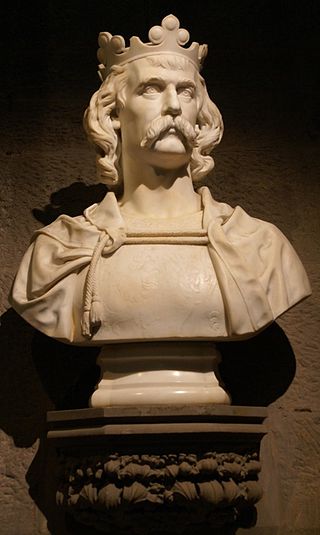
Robert I, popularly known as Robert the Bruce, was King of Scots from 1306 to his death in 1329. Robert led Scotland during the First War of Scottish Independence against England. He fought successfully during his reign to restore Scotland to an independent kingdom and is regarded in Scotland as a national hero.
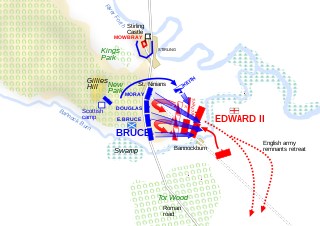
1314 (MCCCXIV) was a common year starting on Tuesday of the Julian calendar, the 1314th year of the Common Era (CE) and Anno Domini (AD) designations, the 314th year of the 2nd millennium, the 14th year of the 14th century, and the 5th year of the 1310s decade. As of the start of 1314, the Gregorian calendar was 8 days ahead of the Julian calendar, which was the dominant calendar of the time.
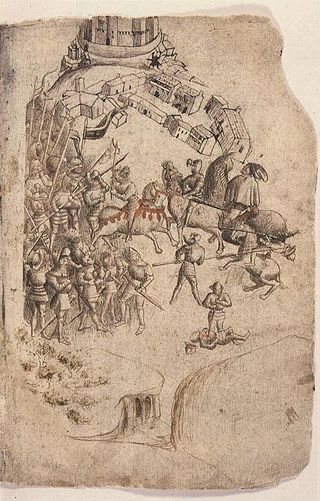
The Battle of Bannockburn was fought on 23–24 June 1314, between the army of Robert the Bruce, King of Scots, and the army of King Edward II of England, during the First War of Scottish Independence. It was a decisive victory for Robert Bruce and formed a major turning point in the war, which ended 14 years later with the restoration of Scottish independence under the Treaty of Edinburgh–Northampton. For this reason, the Battle of Bannockburn is widely considered a landmark moment in Scottish history.

Earl Marshal is a hereditary royal officeholder and chivalric title under the sovereign of the United Kingdom used in England. He is the eighth of the great officers of State in the United Kingdom, ranking beneath the Lord High Constable of England and above the Lord High Admiral. The dukes of Norfolk have held the office since 1672.

The Lord High Steward is the first of the Great Officers of State in England, nominally ranking above the Lord Chancellor.

William de Valence, born Guillaume de Lusignan, was a French nobleman and knight who became important in English politics due to his relationship to King Henry III of England. He was heavily involved in the Second Barons' War, supporting the king and Prince Edward against the rebels led by Simon de Montfort. He took the name de Valence after his birthplace, the Cistercian abbey of Valence, near Lusignan in Poitou.

Alan la Zouche, 1st Baron la Zouche of Ashby was born at North Molton, Devonshire, the only son of Roger La Zouche and his wife, Ela Longespée, daughter of Stephen Longespée and Emmeline de Ridelsford. He received seisin of his father's lands after paying homage to the king on 13 October 1289. Alan was governor of Rockingham Castle and steward of Rockingham Forest. Alan La Zouche died without any sons shortly before at the age of 46, and his barony fell into abeyance among his daughters.
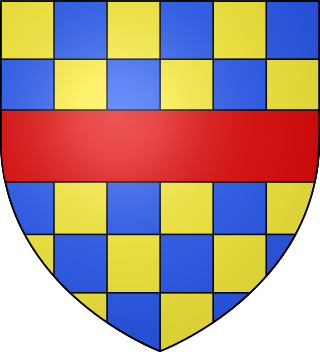
Robert de Clifford, 1st Baron de Clifford, of Appleby Castle, Westmorland, feudal baron of Appleby and feudal baron of Skipton in Yorkshire, was an English soldier who became 1st Lord Warden of the Marches, responsible for defending the English border with Scotland.
Events from the 1310s in England.

Sir Gilbert de la Hay, fifth feudal baron of Errol in Gowrie, was Lord High Constable of Scotland from 1309.

Henry de Percy, 1st Baron Percy of Alnwick was a medieval English magnate.

John Segrave, 2nd Baron Segrave was an English commander in the First War of Scottish Independence.
Marshal of Ireland or Earl Marshal of Ireland is a hereditary title originally awarded to William Marshal, 1st Earl of Pembroke in the Lordship of Ireland, which descended to Baron Morley. The title of Marshal, like that of Baron Morley, has been in abeyance since 1697. William Lynch in 1830 described the duties attached to the office before it became ceremonial:
Sir John Marmion, Baron Marmion of Winteringham was an Anglo-Norman baron who represented Lincolnshire in Parliament and fought in the Wars of Scottish Independence.
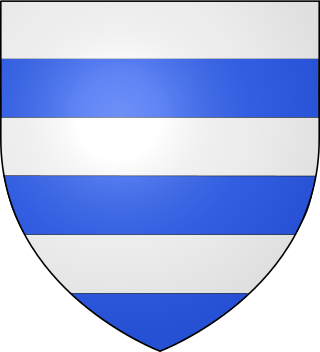
Richard Grey, 2nd Baron Grey of Codnor, of Codnor Castle, was an English soldier and diplomat.
Edmund Hastings, 1st Baron Hastings, Lord of Inchmahome, was an Anglo-Scottish noble. He served as Governor of Perth, Governor of Berwick, Constable of Dundee and Sheriff of Berwick. He was killed during the Battle of Bannockburn against the Scots on 23 or 24 June 1314.

John Lovel, 2nd Baron Lovel, Lord of Titchmarsh, was an English noble. He was killed during the Battle of Bannockburn against the Scots on 23 or 24 June 1314.
John Marshal, 2nd baron Marshal was a minor English noble. He was the son of William Marshal, 1st Baron Marshal.

The Marshal family was a noble family of Anglo-Norman origins. Their name, Marshal, derives from the Frankish term for “a person who tended horses”. By 1066 the term was used for a position in royal and aristocratic households.















